O Korei
Seoul has numerous palaces and royal tombs preserving the history and culture of the Joseon dynasty. These palaces now serve as a place where citizens can enjoy various cultural programs or simply enjoy the atmosphere. In autumn, these palaces hold diverse festivals to enjoy the atmosphere and beauty of the Korean autumn.
In Seoul and the SCA, there are around 40 royal tombs of kings who ruled Joseon throughout its 500-year history. In recognition of their superb historical value, these tombs made it into the UNESCO World Cultural Heritage list in 2009.
The Cultural Heritage Administration Royal Palaces and Tombs Center and the Korea Cultural Heritage Foundation opened nine royal tombs to the public in October (Donggureung, Seooreung, Seonjeongneung, Sejongdaewangneung, Yungneung and Geolleung, Uireung, Taegangneung, Heolleung and Illeung, and Hongyureung) for the Joseon Royal Tombs Festival. The festival offers information on Joseon’s royal tombs, as well as various programs and activities to revisit the meaning of royal tombs for us, including projection mapping, drone performance, and multidisciplinary concerts inspired by the kings of Joseon.
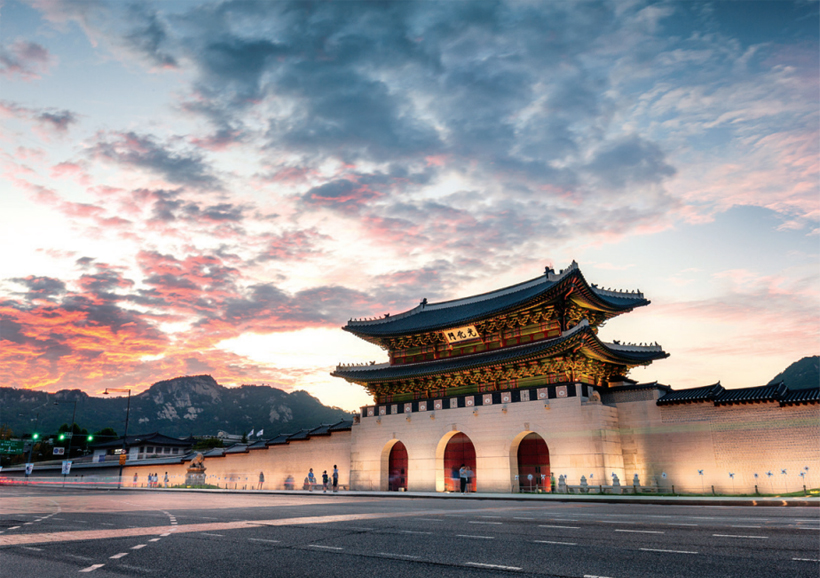
The Moonlight Tour at Gyeongbokgung Palace is one of the most popular tour programs in Korea.
Moonlight Tour at Palaces
A royal palace, which is an indispensable destination for Korean tourism, features distinctly different sentiments between day and night. Tourists flock to the palace during the day to experience a tranquil and relaxed atmosphere. When covered with a veil of darkness, the palace boasts of a different mood. The subtle lighting and mysterious acoustic effects add up different charms. As those attractive features are known through social networking services, royal palaces have recently emerged as new night attractions.
Among royal palaces that open at night are the four major palaces in Seoul (Gyeongbokgung Palace, Changdeok Palace, Changgyeong Palace, and Deoksugung Palace) and Hwaseong Haenggung Palace in Suwon. Whether tour programs are available depends on each royal palace, but if it is, reservations must be made on the website.
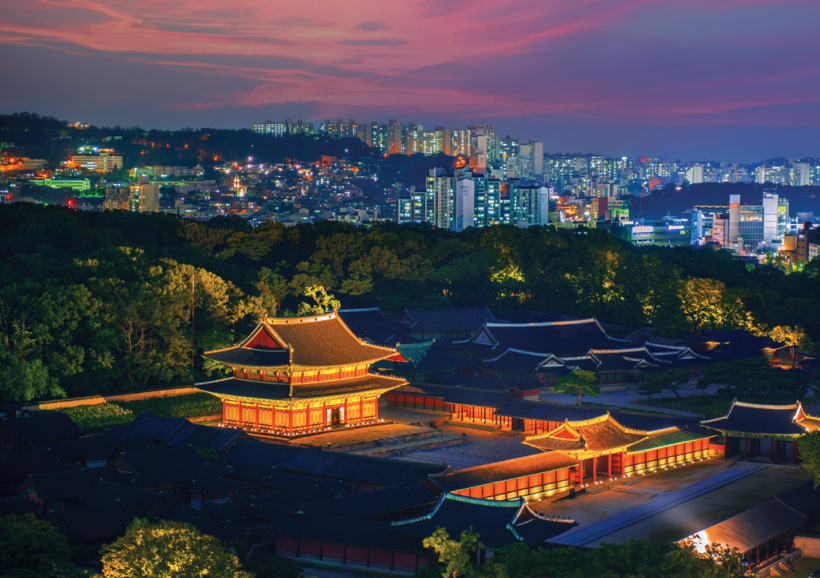
At night, Changdeokgung Palace becomes far more colorful and magical under the moonlight and lighting.
Pungsokdo for All
Experience the royal palaces virtually through a “metaverse.” “Pungsokdo for All” is a metaverse program where participants can create their own characters and visit a virtual royal palace, in the way the MZ generation enjoys metaverse activities. The program was a huge hit among the MZ generation, reaching 330,000 participants just a year after its 2021 launch. The program offers participants a chance to overcome the confines of time and space, explore the ancient palace, and channel their inner creativity into creating unique characters.
Hanok Village
Korea boasts of different types of hanok villages. Located in the heart of Seoul, teeming with high-rise buildings, Bukchon Hanok Village and Namsangol Hanok Village allow visitors to feel the coexistence of the past and the present. In collaboration with the National Trust of Korea, the Simsimheon House in Bukchon is open to the public only on weekends. The “L”-shaped traditional house offers a chance to experience Korea’s traditional maru (wooden-floored hall) and a sweeping view of the Jongno area. With 625 traditional tile-roof houses and modern adaptations of traditional hanok houses, Jeonju Hanok Village is the largest of its kind in Korea. It is widely loved not only for its spectacle but also its wide selection of activities such as tea rituals and traditional paper making, all provided in traditional spaces.
While smaller in size, other hanok villages (Gongju Hanok Village in Chungcheongnam-do, Gangneung Ojuk Hanok Village in Gangwon-do, and Gurim Hanok Village in Yeongam, Jeollanam-do) also provide more than ample opportunities to experience Korean culture. While it is not a hanok village, the Seongyojang House in Gangneung, Gangwon-do is a good place to experience Korea’s traditional housing. The 300-year-old house is still in good shape. It once belonged to a prestigious noble clan (called “sadaebu” in Korean), and their descendants still live in the house to this day.
Sungnyemun Gate and Namdaemun Market
Sungnyemun Gate, unofficially known as Namdaemun Gate, was the gate on the south side of the Fortress Wall of Seoul among eight gates. As Korea’s National Treasure No. 1, it is the largest extant castle gate stone structure. The ancient gate was destroyed in an arson attack in 2008. Following several years of restorative work, Sungnyemun Gate can now be enjoyed in all its glory.
Namdaemun Market is a large traditional market located on the east side of Sungnyemun Gate. Teeming with things to see, shop, and eat, this popular attraction is always crowded with shoppers and tourists. It features not only diverse products such as clothes, kitchenware, home appliances, and daily miscellaneous goods, all of which are available at low prices, but also well-known food alleys such as Galchi Jorim (stewed beltfish) Alley and Kalguksu (noodle soup) Alley.
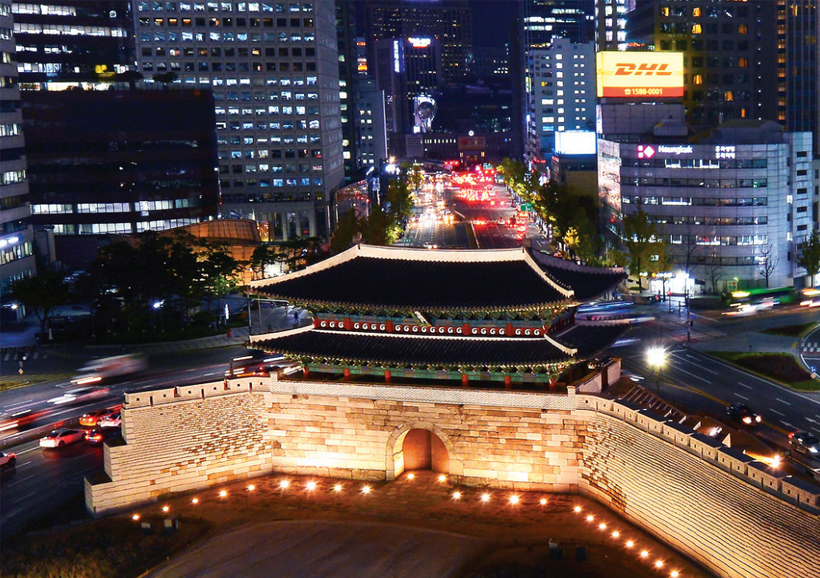
Sungnyemun Gate
Seoul, the capital of the Joseon dynasty, was protected by a long stone wall with eight gates. Sungnyemun (Namdaemun or South Gate), literally meaning the “Gate of Exalted Ceremonies,” is the Korean National Treasure No. 1.
Heunginjimun Gate and Dongdaemun Market
Heunginjimun Gate, unofficially known as Dongdaemun Gate, was the gate on the east side of the Fortress Wall of Seoul among eight gates. Near the gate is a massive commercial district, commonly referred to as Dongdaemun Market.
Dongdaemun Market encompasses Gwangjang Market, Pyeonghwa Market, Sinpyeonghwa Market, and Dongdaemun Shopping Complex. The term “Dongdaemun fashion” was coined because most of these markets deal with the sale of clothes. In addition, they operate in the form of wholesale markets at night and thus create new clothing culture and consumption, contributing greatly to market revitalization.
In 2014, Dongdaemun Design Plaza (DDP), the world’s largest irregular architectural structure, opened in the vicinity of Dongdaemun Market. The futuristic design has somewhat changed the simple and common-class atmosphere of Dongdaemun Market into a modern one, expanding the main consumer base to young people and foreigners.
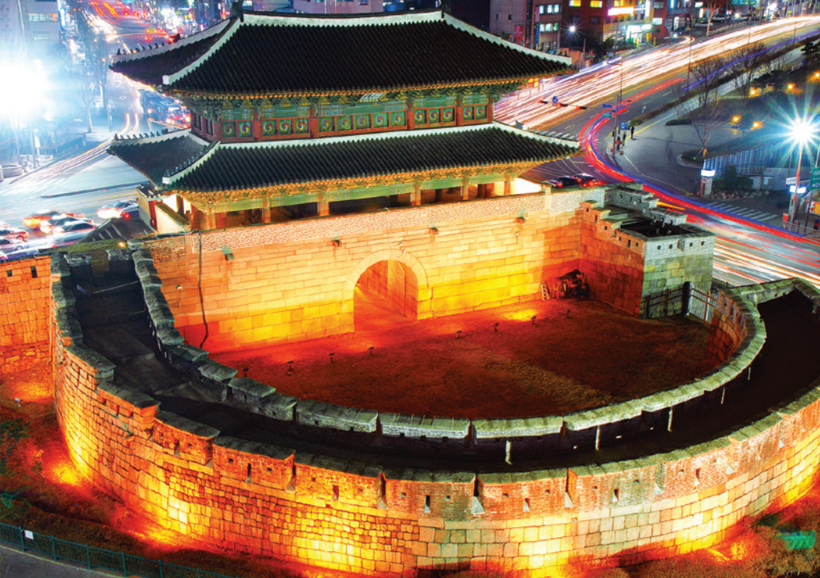
Heunginjimun Gate
Heunginjimun (Dongdaemun or East Gate) is the only one of the eight fortress gates protected by a semicircular gate-guard wall.
Gwanghwamun Square
In August 2022, Gwanghwamun Square once again welcomed citizens after a renovation project. The vehicle lanes on the Sejong Art Center side have been blocked to free up space for pedestrians, opening up a route filled with history from the Statue of Admiral Yi Sun-sin to the Statue of King Sejong, Gwanghwamun Gate, Gyeongbokgung Palace, and Bugaksan Mountain.
Before the renovation, Gwanghwamun Square was a narrow strip flanked by traffic on either side, which restricted people’s access to the square. Blocking the lanes on the Sejong Art Center side freed up space for pedestrians between the lanes and the square.
The change was found to increase the time that visitors spend in the square. Many visitors rest their legs sitting on the stone stairs in front of the art center, or talk with friends sitting on chairs placed across the square. In addition, many visitors from outside the country begin their Seoul tour at the square, as it offers easy access to various tourist attractions. For these reasons and others, Gwanghwamun Square is set to become a new landmark for the capital city.
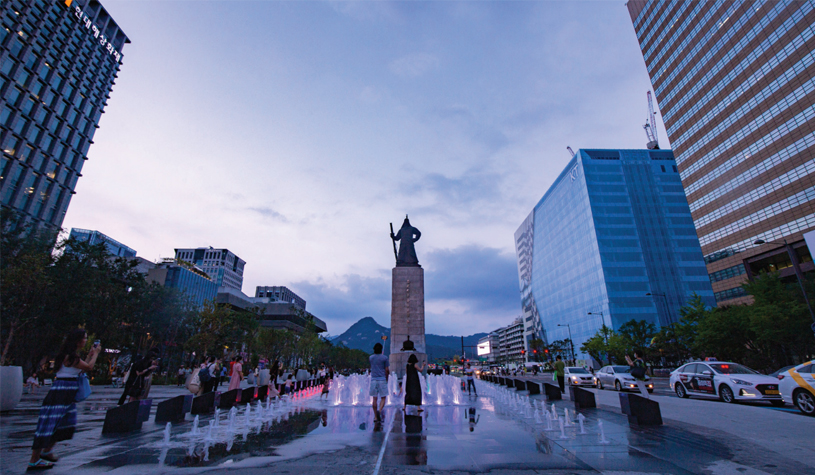
Gwanghwamun Square
The road in front of Gwanghwamun Gate is the central space in Korea and is the most important place for people to gather, meet, and share news and opinions.
Songhyeon-dong Site
The Songhyeon-dong Site in Jongno-gu, Seoul, returns to citizens after 100 years. The Songhyeon-dong Site is three times larger than Seoul Plaza (37,117 m2). Once belonging to an accommodation facility for the United States Embassy in Korea after the 1945 Liberation of Korea, the site used to be surrounded by high walls blocking the view from the outside. It had been left empty since the facility was relocated in the late 1990s. In October 2022, the 4-meter walls were lowered to 1.2 meters, giving citizens a full view of the old site.
Culture Station Seoul 284 & Seoullo 7017
Culture Station Seoul 284 is a culture and art space built by repurposing the old Seoul Station building. To preserve its historical significance as the oldest railroad building in Korea, the place was redesigned into a public culture and art space while maintaining the look it had at the time of its first opening in 1925.
Seoullo 7017 is a walking trail repurposed from an old overpass connecting to the Seoul Station. The 1.5 km pass from Malli-dong 1-ga to the Hoehyeon Station is now a trail decorated with trees and flowers. “70” in “7017” refers to 1970, the year when the overpass was built, and “17” means 2017, the year when Seoullo officially opened. The trail offers a view of major historical sites in Seoul, including the old station, the Namdaemun Gate, and the new Seoul Station.
Museums and Art Museums
Museums and Art Museums represent the culture and history of a country. Therefore, they also serve as measures for assessing the level of its cultural maturity. That is why people visiting other countries tend to visit museums and art museums first.
Korea’s national museums and art museums are also designed to educate people about the country’s history and offer a chance to enjoy culture and art.
As of 2022, Korea has a total of 1,171 museums and art museums across its 17 major cities and provinces (52 national museums, 462 public museums, 537 private museums, and 120 university museums).
Each of the museums and art museums offers different artifacts and exhibits, widening the scope of cultural enjoyment available.
National Museum of Korea
Launched in October 2005 at Seobinggo-ro, Yongsan-gu, Seoul, the National Museum of Korea (NMK) has around 300,000 relics in a 300,000 m2 area.
The main building (1 basement and 6 stories) includes a storage facility to preserve relics, exhibition halls, and research spaces.
The first exhibits that welcome visitors into the museum are the Ten-Story Stone Pagoda from Gyeongcheonsa Temple Site and the Twin Lion Stone Lantern from Godalsa Temple Site. The Ten-Story Stone Pagoda from Gyeongcheonsa Temple Site was built at the temple in 1348 (4th Year of King Chungmok’s reign, Goryeo Period). The use of grey marble indicates influence from the Yuan Dynasty. It was taken by Japan in 1909 and subsequently returned to Korea. It was placed at Gyeongbokgung Palace in 1960 before its relocation to the NMK. The Twin Lion Stone Lantern was originally found at the Godalsa Temple Site in Sanggyo-ri, Yeoju, Gyeonggi-do. It was moved to Gyeongbokgung Palace in 1959 before being relocated to its current position at the NMK.
The museum’s central lobby is surrounded by the Prehistory and Ancient History Gallery, Medieval and Early Modern History Gallery, Donations Gallery, Calligraphy and Painting Gallery, World Art Gallery, and Sculptures and Crafts Gallery, each featuring a vast collection of exhibits. It takes around seven days to appreciate them in full. Therefore, it would be wiser to plan which halls to visit in advance.
The main features of the museum include the Gilt-bronze Pensive Maitreya Bodhisattva; earthenware from the Bronze Era; tomb murals of Goguryeo, the Gangseodaemyo Tomb; Baekje artifacts from the Gongju Suchon-ri Burial Site and the Tomb of King Muryeong; Gold Crown and Gold Waist Belt from Silla; and the Gilt-bronze Standing Buddha Triad.

National Museum of Korea
You can fully enjoy six permanent exhibition halls presented by era and theme, a special exhibition hall that features a variety of content, a children’s museum where you can enjoy and learn with all five senses, and immersive content using cutting-edge technology.
National Museum of Modern and Contemporary Art, Korea
The National Museum of Modern and Contemporary Art (MMCA) archives works of Korean artists and organizes permanent and special exhibitions that indicate the current status of Korean art.
Since its initial grand opening of MMCA Gwancheon in Gyeonggi-do, the museum added three more locations: MMCA Seoul, MMCA Deoksugung, and MMCA Cheongju in Chungcheongbuk-do.
MMCA Gwacheon hosts The More, The Better, a video artwork by the globally renowned media artist Paik Nam June. The More, The Better was originally created in 1988 with 1,003 TV monitors donated by Samsung Electronics. The piece went through repeated maintenance for three decades to replace dilapidated monitors. Unfortunately, the piece was deactivated altogether in 2018 due to fire concerns. After three years of restoration, the piece was reactivated on September 15, 2022, and revealed to the public. In celebration of the reactivation, MMCA held the special archival exhibition Merry Mix: The More, The Better, along with an academic symposium to revisit the art of Paik Nam June.
National Hangeul Museum
Hangeul has recently become one of the most beloved writing systems in the world. People worldwide take Hangeul and Korean language courses to learn the language, and many foreigners come all the way to the country to enroll in Korean language institutes.
The National Hangeul Museum (NHM) is committed to helping visitors experience the excellence, significance, and aesthetics of Hangeul.
Located in Yongsan-gu, Seoul, the NHM organizes and offers various exhibitions that shed light on Hangeul from diverse perspectives. In addition, the museum works with visual artists, crafters, fashion designers, musicians, and other artists to create content highlighting the excellence and beauty of Hangeul.
The museum also maintains a vast collection of important pieces of Hangeul’s history, including the manuscript of Malmoi, the first Korean dictionary written by Ju Si-gyeong; Sound of Words, a Korean grammar book; Ahakpyeon, a foreign language textbook written by Ji Seok-yeong; and Dongnip sinmun (The Independent), which adopted the modern spacing system for Korean writing.
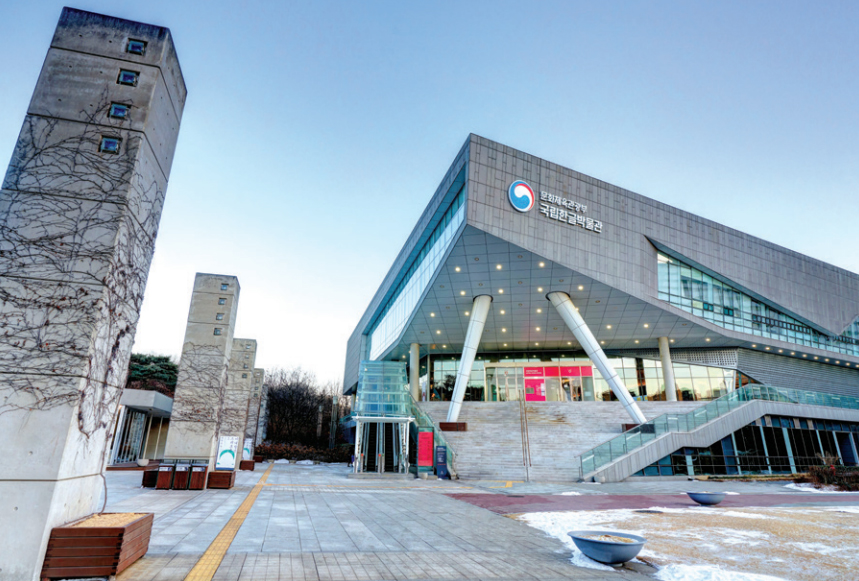
National Hangeul Museum
The museum provides exhibitions, experiences, and learning opportunities to awaken the history, values, and excellence of Hangeul, Korea’s system of writing.
Seoul Museum of Craft Art
“Craft (gongye in Korean)” means the art of making various objects used in daily routines. However, today, it is considered a genre of art as it involves both the instrumental and aesthetic aspects of objects.
Seoul Museum of Craft Art (SeMoCA), which opened in July 2021 in Anguk-dong, Jongno-gu, Seoul, provides a glimpse into Korean aesthetics as represented in their craftworks. From objects containing uniquely Korean elements such as mother-of-pearl (jagae), quilt (jogakbo), bamboo, and knots to the works of contemporary crafters, the museum holds around 20,000 craftworks. It also manages an archive of materials and documents to promote an understanding of Korea’s traditional crafts.
In addition to its free, permanent exhibitions, SeMoCA offers a wide selection of craft activity programs offering more hands-on experience. Details about the programs can be found on the museum website.
Leeum Museum of Art
Leeum Museum of Art is a private art museum run by Samsung Foundation of Culture. The name “Leeum” combines “Lee” from the founder of Samsung Group, Lee Byung-chul, and “um” from the word “museum.”
The museum preserves the traces of the founder and the late Chairman Lee Kun-hee, who were well-known for their deep love for art. The museum holds 36 National Treasures and 96 Treasures, and the buildings were designed by world-renowned architects Rem Koolhaas, Mario Botta, and Jean Nouvel. The three buildings are organically interconnected, and feature exhibition spaces where visitors can appreciate a wide range of exhibits, from ancient artifacts from the Bronze Era and the Three Kingdoms Period, Goryeo celadons, Buddhist paintings, and other ancient artworks, to the works of contemporary giants such as Park Seo-bo, Anish Kapoor, and Damien Hirst.
Lee Ufan Museum
In the 20th century, the video artist Paik Nam June was one of the most well-known Korean artists. He carved out his presence in the world history of art by creating a new genre, video art, based on his unique philosophy.
In the 21st century, Dansaekhwa emerged as artworks representing Korea. Abstract works by Park Seo-bo, Ha Chong Hyun, Lee Ufan, and others have been widely loved by art enthusiasts across the world.
In April 2022, Lee Ufan Museum opened in Arles, France. Located in a repurposed mansion built between the 16th and 18th centuries, the museum displays Lee’s major works for European visitors. This is the second Lee Ufan Museum to be founded outside of Korea, after the foundation of the Lee Ufan Museum in Naoshima in 2010. The museum in Naoshima was designed by the renowned Japanese architect Ando Tadao. Then, in 2015, the Space Lee Ufan was created inside the Busan Museum of Art.
Frieze Art Fair Comes to Korea
With the growing popularity of Korean art, or K-art, the Korean art market also drew attention from music market players across the world in terms of its purchasing power and influence.
The growth of the Korean art market is evidenced by the collaboration between Frieze, one of the largest art fairs in the world, and the major Korean art fair KIAF in Seoul in September 2022. Furthermore, the fact that Frieze chose Seoul over Hong Kong or Japan proves the rise of the Korean art market as a hub for Asian art markets.
Lim Yunchan, the Renaissance of K-Classic
On June 18, 2022, Pianist Lim Yunchan won gold at the Van Cliburn International Piano Competition at the age of 18. He became the youngest winner in the 60-year history of the competition, surpassing the previous records held by Zhang Haochen in 2009 and Cristina Ortiz in 1969, both of whom won the competition at 19.
The largest music competition in North America, the Van Cliburn Competition produced some of the world’s greatest pianists, such as Radu Lupu (winner in 1966), Alexei Sultanov (1989), and Olga Kern (2001).
Along with Cho Seong-jin, who has been actively performing across the world after winning the 17th International Chopin Piano Competition in 2015, the success of Lim Yunchan made Korea one of the key powers in the global classical scene.

Pianist Lim Yunchan
Lim Yunchan was given the opportunity to tour the world for three years by winning the Van Cliburn International Piano Competition. In 2023, he will tour the U.S. and Europe, including New York, London, and Paris.
Baritone Kim Gihoon
Baritone Kim Gihoon proved his vocal prowess on the global stage. In June 2021, Kim won the BBC Cardiff Singer of the World competition (aria category). The win came after a series of stellar performances at international competitions, including second place at the 2019 International Tchaikovsky Competition (male vocal category) and the 2019 Operalia competition (The World Opera Competition).
Broadcast live by BBC Television, BBC Cardiff Singer of the World is a major vocal competition won by great vocalists such as Bryn Terfel and Dmitri Hvorostovsky
Hangeul Power - King Sejong Institute
The global popularity of Korean content has meant an increase in people interested in learning Korean. According to a survey by the King Sejong Institute Foundation, the number of students learning Korean at King Sejong Institutes across the world has been on a steady rise, from 72,713 in 2019 to 76,528 in 2020 and 81,476 in 2021. The number of the institutes also increased, from 180 locations across 60 countries in 2019 to 213 locations across 78 countries in 2020, and 234 locations across 82 countries in 2021. The King Sejong Institute Foundation attributes this growth to the global popularity of Korean content, saying that the positive experience provided by K-content translates into new demand for learning Hangeul and the Korean language.
In 2022, new King Sejong Institutes were founded in seven countries, including South Africa, Luxembourg, Bangladesh, Saudi Arabia, Kuwait, Tunisia, and Finland, increasing the total number of overseas locations to 244 across 84 countries.
